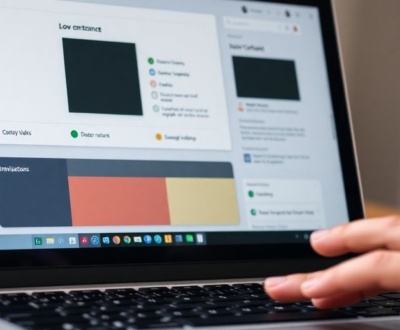Ever tried to read something online and the colors just clashed so bad you couldn’t make out the words? Or maybe you’ve squinted at a chart because the colors were too similar? Yeah, that happens a lot. And it’s not just annoying; it actually makes it hard for many people to use websites and apps. This article is all about making sure your designs are easy on everyone’s eyes. We’ll talk about how to pick colors that work for everybody, including those with vision problems. It’s about designing smart, so your stuff reaches more people.
Key Takeaways
- Good color choices mean more people can use your designs. Think about everyone, not just yourself.
- The WCAG guidelines are like a rulebook for color. They tell you how much contrast you need between colors.
- You can use online tools to create color palettes that are already set up to be accessible. It saves you a lot of guesswork.
- Always check your color combinations. Make sure there’s enough difference between text and background colors.
- Some color pairs, like red and green, can be tricky for people with color blindness. Try to avoid using them together for important information.
Understanding Accessible Color Palette Generation
Defining Accessible Color Palettes
So, what exactly is an accessible color palette? It’s more than just picking colors that look nice together. It’s about choosing colors that everyone can see and use effectively, including people with visual impairments. Think of it as designing with empathy. An accessible palette considers how different people perceive color, ensuring that information isn’t lost due to poor contrast or problematic color combinations. It’s about making your designs inclusive and usable for the widest possible audience. It’s not just a trend; it’s good design.
Importance of Color Accessibility
Why should you care about color accessibility? Well, for starters, it’s the right thing to do. But beyond that, it makes good business sense. By ensuring your designs are accessible, you’re opening them up to a much larger audience. Think about it: a significant portion of the population has some form of visual impairment. If your website or infographic is difficult for them to use, they’re likely to go elsewhere. Plus, accessible design often leads to better design overall. When you focus on clarity and contrast, you create a better user experience for everyone. It’s a win-win. You can plan your color scheme in advance to avoid issues.
WCAG Guidelines for Color Contrast
Okay, so how do you actually do this? That’s where the Web Content Accessibility Guidelines (WCAG) come in. WCAG provides specific guidelines for color contrast to ensure that text and interactive elements are readable for people with visual impairments. The key metric here is the contrast ratio, which measures the difference in luminance between two colors. WCAG AA requires a contrast ratio of at least 4.5:1 for normal text and 3:1 for large text. WCAG AAA (the highest level of accessibility) requires even higher contrast ratios. It might sound complicated, but there are plenty of tools out there to help you measure contrast ratios and ensure you’re meeting the guidelines.
Meeting WCAG standards isn’t just about ticking boxes; it’s about creating a more inclusive and user-friendly experience for everyone. By prioritizing color contrast, you’re making your content more accessible to people with visual impairments, older adults, and anyone who might struggle to read low-contrast text.
Here’s a quick rundown of WCAG contrast requirements:
- WCAG AA: 4.5:1 for normal text, 3:1 for large text
- WCAG AAA: 7:1 for normal text, 4.5:1 for large text
- These ratios apply to text and interactive elements
- Use contrast analysis tools to measure your color combinations
Generating Accessible Color Palettes
Okay, so you know why accessible color palettes are important. Now, how do you actually make one? It’s not as hard as it sounds, especially with the tools available today. Let’s break down some methods.
Utilizing a Color Palette Generator
Color palette generators are your best friend. Seriously. There are tons of free online tools that take the guesswork out of creating accessible color schemes. These generators are designed to ensure that the color combinations meet WCAG standards, so you don’t have to manually calculate contrast ratios. It’s like having a color accessibility expert in your pocket. You can even generate accessible palettes in seconds.
Here’s a simple process:
- Find a reputable color palette generator (there are many free ones!).
- Choose a base color or let the generator pick one randomly.
- Explore the suggested color combinations.
Using a color palette generator can save you a ton of time and effort. It’s a great way to quickly create accessible color schemes without needing to be a color theory expert.
Generating Palettes from HEX Codes
Got a favorite color already? No problem! Most color palette generators let you input a HEX code and then generate an accessible palette around that color. This is super useful if you have brand colors you need to work with. The generator will find complementary colors that meet the required contrast ratios. It’s a great way to ensure your brand colors are accessible without sacrificing your brand identity. You can input a HEX code to discover accessible palettes.
Randomizing Color Palette Generation
Feeling adventurous? Sometimes the best color palettes come from unexpected places. Many generators have a "randomize" feature that spits out a completely random color palette. This can be a fun way to discover new color combinations you might not have considered otherwise. Just make sure to double-check the contrast ratios to ensure they meet accessibility standards. It’s like a surprise grab bag of color combinations! Don’t think twice — roll the dice and generate palettes based on a random color.
Key Principles for Accessible Design
Prioritizing High Contrast Combinations
When it comes to accessible design, contrast is your best friend. High contrast makes content easier to see for everyone, not just those with visual impairments. Think black text on a white background, or a dark blue button on a light yellow background. The bigger the difference in brightness between the text and its background, the better. It’s a simple principle, but it makes a world of difference.
Avoiding Problematic Color Pairings
Some color combinations are just a no-go when it comes to accessibility. Red and green is a classic example, since a significant portion of the population has trouble distinguishing between them. But there are other combinations to watch out for too, like blue and yellow, or even certain shades of gray. It’s not just about color blindness either; low contrast pairings can be difficult for anyone to read, especially on screens with poor resolution or in bright sunlight.
Here’s a quick list of color combos to be cautious of:
- Red and Green
- Blue and Yellow
- Light Gray and White
- Pastel Shades Together
Designing for Various Visual Impairments
Accessibility isn’t just about color blindness; it’s about considering a whole range of visual impairments. Some people have low vision, meaning they can see, but their vision is blurry or limited. Others might have cataracts, which can affect color perception and contrast sensitivity. And then there are those with light sensitivity, who may find bright colors overwhelming or painful. When designing, think about how your color choices will affect people with all sorts of visual challenges.
Designing for accessibility is about empathy. It’s about putting yourself in someone else’s shoes and thinking about how they’ll experience your design. By considering the needs of people with visual impairments, you’re not just making your design more accessible; you’re making it better for everyone.
Testing Your Accessible Color Palette
Measuring Color Contrast Ratios
So, you’ve got a color palette you think is accessible? Great! Now it’s time to put it to the test. The most important thing here is the color contrast ratio. This ratio determines how well people with visual impairments can distinguish between text and background, or between different elements in your design. It’s expressed as a number, like 4.5:1 or 7:1. Higher is better. Basically, you need to measure the contrast between every color pairing in your design – text on background, buttons on background, etc.
Tools for Contrast Analysis
Luckily, you don’t have to do this math by hand. There are tons of tools out there to help you check contrast ratios. Some are online, some are browser extensions, and some are built into design software. Here are a few things you can do:
- WebAIM’s Contrast Checker: A simple online tool where you enter your foreground and background colors (usually as HEX codes) and it tells you the contrast ratio and whether it meets WCAG standards.
- Color Contrast Analyzer (CCA): A downloadable tool for Windows and Mac that lets you pick colors directly from your screen.
- Browser extensions: Many browsers have extensions that can analyze the contrast of elements on a webpage.
It’s a good idea to use more than one tool to double-check your results. Sometimes different tools can give slightly different readings, so it’s best to be thorough.
Ensuring WCAG AA Compliance
WCAG, or Web Content Accessibility Guidelines, is the gold standard for web accessibility. To meet WCAG AA compliance (which is what most people aim for), you need to meet certain contrast ratio requirements:
- 4.5:1 for normal text: This means the contrast ratio between your body text and its background needs to be at least 4.5:1.
- 3:1 for large text: If your text is large (18pt or 14pt bold), the contrast ratio can be slightly lower, at 3:1.
- 3:1 for user interface components and graphics: Things like buttons, form fields, and icons also need to have a contrast ratio of at least 3:1 with their surroundings.
If your color palette doesn’t meet these ratios, you’ll need to tweak it. This might mean making your text darker, your background lighter, or choosing completely different colors. It can be a bit of a pain, but it’s worth it to make your designs accessible to everyone.
Applying Accessible Colors to Your Designs
It’s one thing to generate an accessible color palette, but it’s another to actually use it effectively in your designs. Let’s explore how to integrate these palettes into your projects to ensure maximum impact and accessibility.
Integrating Palettes into Infographics
Infographics are a great way to visualize data, but they can quickly become inaccessible if color choices aren’t carefully considered. Start by selecting a base color from your accessible palette for the background. Then, use contrasting colors for text, charts, and other visual elements. Remember, the goal is to make the information easy to understand for everyone, including those with visual impairments. Tools like Venngage’s Infographic Maker can help you experiment with different color combinations and templates.
Experimenting with Design Templates
Don’t be afraid to play around with different design templates to see how your accessible color palette works in various contexts.
- Try applying your palette to website layouts, marketing materials, and presentations.
- Pay attention to how the colors interact with each other and whether they maintain sufficient contrast in different scenarios.
- Consider using templates as a starting point and then customizing them to fit your specific needs while adhering to accessibility guidelines.
It’s important to remember that accessibility isn’t just about meeting minimum contrast ratios. It’s about creating a visually appealing and user-friendly experience for all users. Experimenting with design templates can help you find the right balance between aesthetics and accessibility.
Making Accessibility a Core Design Principle
Accessibility shouldn’t be an afterthought; it should be a core design principle. Incorporate accessibility considerations from the very beginning of your design process. This means choosing colors, fonts, and layouts that are inherently accessible, rather than trying to fix accessibility issues later on. By making accessibility a priority, you can create designs that are not only visually appealing but also inclusive and user-friendly for everyone.
Common Color Combinations to Avoid

It’s easy to fall into the trap of using visually appealing color combinations without considering accessibility. Some pairings, while aesthetically pleasing to some, can present significant challenges for individuals with visual impairments, especially color blindness. Let’s explore some common color combinations that should be approached with caution.
Red and Green Distinctions
Red and green colorblindness is the most common type of color vision deficiency. About 5% of the population has trouble distinguishing between red and green. This means that using these colors together, especially for conveying important information, can exclude a significant portion of your audience. Imagine a chart where gains are shown in green and losses in red – a person with red-green colorblindness might struggle to interpret the data accurately. It’s best to avoid using these colors as the sole means of conveying information. Consider using patterns, labels, or alternative color schemes to ensure inclusivity. You can use an accessible color palette generator to help you.
Challenges with Red and Black
While not as problematic as red and green, red and black combinations can still pose challenges. The contrast between these colors can be difficult for some people to perceive, especially if the red is not a very bright shade. This can lead to eye strain and difficulty reading text. It’s important to test the contrast ratio of red and black combinations to ensure they meet accessibility standards. If the contrast is too low, consider using a lighter shade of red or a different color altogether. Here are some things to consider:
- The specific shades of red and black used significantly impact contrast.
- Text size and font weight also play a role in readability.
- Background lighting conditions can affect how the colors are perceived.
When in doubt, always err on the side of caution and choose color combinations that offer high contrast and are easily distinguishable by people with various types of visual impairments.
Blue and Yellow Considerations
Although less common than red-green colorblindness, blue-yellow colorblindness does exist. While many people can distinguish between blue and yellow, certain shades and combinations can still be problematic. For example, using light blue text on a yellow background can be difficult to read due to low contrast. Similarly, using these colors to represent opposing data points in a chart might not be the best choice. Always test your color combinations with a color blind friendly palette simulator to ensure they are accessible to everyone. Remember, accessibility is not just about meeting minimum requirements; it’s about creating a user experience that is inclusive and enjoyable for all.
Benefits of an Accessible Color Palette

Reaching a Wider Audience
Accessible color palettes are not just about compliance; they’re about inclusivity. By choosing colors that meet accessibility standards, you open your designs to a much larger audience, including individuals with visual impairments. This means more people can understand and engage with your content. It’s a simple change that can have a big impact. Think about it: if your website is difficult to read, you’re essentially turning away potential customers or users. Using an accessible color generator tool ensures that everyone has a fair chance to interact with your work.
Enhancing User Experience for All
It’s easy to think that accessible design only benefits those with disabilities, but that’s not the case. High-contrast color combinations improve readability for everyone, regardless of their vision. This can lead to a better user experience overall. When text is easy to read, people can quickly grasp the information you’re presenting. This is especially important for websites and apps where users are often multitasking or have limited attention spans. A well-designed color palette can make your content more engaging and enjoyable for all users.
Here’s a quick look at how contrast affects readability:
- High Contrast: Easier to read, reduces eye strain.
- Low Contrast: Difficult to read, can cause fatigue.
- Appropriate Contrast: Meets WCAG guidelines, accessible to most users.
Accessible design is good design. When you prioritize accessibility, you’re not just helping people with disabilities; you’re creating a better experience for everyone.
Adhering to Ethical Design Practices
Choosing accessible colors is more than just a technical requirement; it’s an ethical one. By making your designs accessible, you’re demonstrating a commitment to inclusivity and social responsibility. This can enhance your brand’s reputation and build trust with your audience. Here are a few reasons why ethical design matters:
- It promotes equality and fairness.
- It shows respect for all users.
- It can improve your brand image.
It’s about making a conscious effort to ensure that your designs are usable by as many people as possible. By prioritizing accessibility, you’re sending a message that you value all of your users, regardless of their abilities. This can lead to increased customer loyalty and positive word-of-mouth. Remember to always check the color contrast to ensure it meets the minimum requirements.
Wrapping Things Up
So, there you have it. Making sure your colors work for everyone isn’t some super complicated thing. It’s really about being thoughtful and using the right tools. You don’t need to be a design guru to get this stuff right. Just remember, a little bit of effort in the beginning can make a huge difference for your audience. It’s about making sure nobody gets left out, and honestly, that just feels good.
Frequently Asked Questions
What is an accessible color palette?
An accessible color palette is a set of colors picked to make sure everyone can easily see and understand your designs. This means people with different kinds of vision, like those who are colorblind or have trouble seeing certain colors, can still get the message. It’s about using colors that stand out enough from each other, especially for text and backgrounds, so nothing gets lost. These palettes follow special rules, like the WCAG guidelines, which help make sure there’s enough difference between colors.
Why is color accessibility important?
Making sure your colors are accessible is super important because it helps everyone understand your stuff. If your colors are hard to see, some people might miss out on important information or feel left out. By using accessible colors, you’re making sure your designs are fair and welcoming to everyone, no matter how they see the world. It breaks down barriers and lets more people enjoy what you create.
How do you know if a color is accessible?
To check if a color is accessible, you need to look at its contrast with the colors next to it. Think of it like how much a dark shirt stands out against a light wall. There are many free tools online that can measure this for you. They give you a number called a contrast ratio. If this number is high enough, your colors are probably good to go. You can also use special color generators that automatically pick accessible colors for you, taking the guesswork out of it.
What colors are good for the visually impaired?
The best colors for people with vision problems can depend on their specific condition. But generally, bright, clear colors are often easier to see than light, faded ones. For example, a strong red usually stands out more than a pale pink. However, it’s not just about one color; it’s about how colors work together. A bright red might be easy to see on its own, but if you put it with a certain green, someone who is colorblind might not be able to tell them apart. So, always think about the whole picture and how colors contrast with each other.
Can any color be used in an accessible color palette?
Yes, you can use almost any color in an accessible design, but you have to be smart about how you pair them. The main thing is to make sure there’s enough contrast between colors, especially between text and its background. This means you might need to use a darker shade of a color with a lighter shade of another, or vice versa. While you might not be able to use every single color exactly as you first imagined, you can still be very creative. The goal is to make sure your designs are both beautiful and easy for everyone to use.
What’s the best way to design an accessible color palette?
Making your designs accessible from the start is a smart move. Instead of picking colors and then checking if they work, try to choose colors that are known to be accessible right away. This often means picking colors that have a strong difference between them, like a dark color for your words and a light color for the background, or the other way around. By thinking about accessibility early in your design process, you can save time and make sure your final product is welcoming to everyone.
About this blog
We are a digital marketing company with a focus on helping our customers achieve great results across several key areas.
Request a free quote
We offer professional SEO services that help websites increase their organic search score drastically in order to compete for the highest rankings even when it comes to highly competitive keywords.









